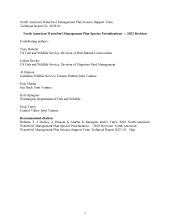
EXECUTIVE SUMMARY
The waterfowl management community has long been committed to restoring waterfowl populations, using periodic updates to the North American Waterfowl Management Plan (NAWMP or the Plan) to identify and communicate changing priorities. The current document builds upon previous iterations of NAWMP by considering several important aspects of the Plan and including contemporary data. The North American Waterfowl Management Plan was developed as a strategy to restore waterfowl populations and through several updates the Plan’s focus has remained waterfowl conservation, but the number of waterfowl species and populations (>70) requires strategic thinking in prioritizing management efforts. In 2004, the Plan prioritized waterfowl species in terms of perceived management need given habitat conditions and importance in harvest (NAWMP 2004). Additional biological and social data are now available along with updated goals of the Plan. In particular, the 2012 Plan Update added social values associated with waterfowl as important objectives of the Plan.
The three primary Plan goals were used to identify classification criteria and prioritize species within all ducks and geese and swans combined. The classification criteria are presented in Table 1 and the results of the above methods are presented in tables 3 and 4. High priority was assigned for 12 of 38 duck species (40 populations). For geese/swans, 11 of 35 populations were classified as High priority.
The waterfowl species prioritization was updated to account for a wider range of social values, accommodate additional current data, and achieve Plan goals. This update relies heavily on the Avian Conservation Assessment Database (ACAD) created by Partners in Flight (2021). The primary source for many ACAD criteria included expert opinion of waterfowl managers, including the NAWMP Science Support Team and associated Joint Ventures. For ducks, the waterfowl population objective of the Plan was scored using population trend information from ACAD and the habitat objective was scored using ACAD threats to breeding and non-breeding habitats. To address the human dimensions objectives, two criteria were used for ducks, total harvest from federal harvest surveys and observations by bird watchers using eBird. For geese/swan populations, the population objective used the most recent 10-year trend in relation to population abundance. The ACAD habitat threats scores were used to classify populations for the habitat objectives of the Plan. For the human dimensions objectives of goose/swan prioritization, population objectives defined in flyway management plans were assumed to represent societal goals for management, and scores were based on the qualitative difference between management plan objectives and current population abundance. For each group the scores of the three categories were averaged so the objectives of the Plan were equally weighted. The range of final scores among populations were subdivided approximately equally to obtain 3 levels of prioritization (high, medium, or low) for ducks and geese/swans.
This report focuses solely on the continental scale. Upon completion of this report, work will commence towards updating regional level scores at the appropriate scale. The continental and regional prioritization will then be updated as needed and as additional information is obtained. The NAWMP Science Support Team (NSST) will work directly with ACAD to prioritize updating expert opinion and trend data at time intervals that are relevant to strategic planning and management decisions.
